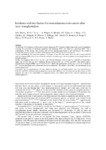Incidence and risk factors for nonmelanoma skin cancer after heart transplantation

View/
Use this link to cite
http://hdl.handle.net/2183/14989Collections
- Investigación (FEP) [507]
Metadata
Show full item recordTitle
Incidence and risk factors for nonmelanoma skin cancer after heart transplantationAuthor(s)
Date
2010-08-03Citation
Molina BD, Leiro MGC, Pulpón LA, Mirabet S, Yáñez JF, Bonet LA, et al. Incidence and risk factors for nonmelanoma skin cancer after heart transplantation. Transplant Proc. 2010;42(8);3001-3005
Abstract
[Abstract] Introduction. The incidence of skin cancer in heart transplant (HT) patients is higher than in the general population, reversing the proportion of cutaneous squamous cell carcinoma (SCC) and basal cell carcinoma (BCC) with a predominance of the former. The etiologic role of new immunosuppressants is not well known. We sought to ascertain the incidence of SCC and BCC in HT patients and the risk factors for its occurrence.
Patients and Methods. We report the incidence of all types of post-HT skin cancer, SCC, and BCC among adult HT patients in Spain (4089 subjects) as well as the influence of gender, age at heart transplant, immunosuppression, and sunlight exposure.
Results. The incidence rates of SCC and BCC, per 1000 persons/year, were 8.5 and 5.2, respectively. Males had a higher risk of SCC but not BCC. Induction therapy increased the risk of SCC and BCC. The relative risk of mycophenolate mofetil (MMF) was 0.3 (0.2–0.6; P < .0005) and azathioprine (AZA) 1.8 (1.2–2.7; P < .0032) for SCC, whereas tacrolimus and cyclosporine showed no difference. The relative risk of BCC was not affected by any immunosuppressant.
Conclusion. Age at transplantation >45 years, induction therapy use, and high sunshine zone were risk factors for both SCC and BCC. Different immunosuppressive agents have different risks of nonmelanoma skin cancer, as AZA increases the risk of SCC and MMF is a protective factor. The relative risk of BCC was not affected by any immunosuppressor.
Editor version
Rights
Creative Commons Licence Reconocimiento-NoComercial-SinObraDerivada 4.0 Internacional






